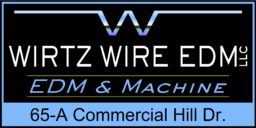Wirtz Wire EDM Inc., Hendersonville, NC, has customers from the aerospace, automotive, mold and die, turbine and fluid power industries. Before acquiring this new CMM in late 1999, Wirtz checked dimensions using an optical comparator, hand tools, and elaborate set-ups. Previously, operators spent an average of two hours per shift inspecting; now, the same job takes only 15 minutes per shift. The methodology change has reduced inspection labor costs by 75 percent, so Wirtz recovered the $20,000 price of the machine in less than a year.
New CMM comes with its own computer system
A North Carolina shop checks a variety of milled, turned and round parts. It has greatly improved process control and cut its inspection costs by about $25,000 a year. This improvement comes as a result of upgrading to a manual coordinate measuring machine (CMM)–specifically Mitutoyo America Corp.’s M-507 CMM.
Wirtz Wire EDM Inc., Hendersonville, NC, has customers from the aerospace, automotive, mold and die, turbine and fluid power industries. Before acquiring this new CMM in late 1999, Wirtz checked dimensions using an optical comparator, hand tools, and elaborate set-ups. Previously, operators spent an average of two hours per shift inspecting; now, the same job takes only 15 minutes per shift. The methodology change has reduced inspection labor costs by 75 percent, so Wirtz recovered the $20,000 price of the machine in less than a year.
Patrick Wirtz, president of Wirtz Wire EDM Inc. of Hendersonville, NC inspects a complex part on a Mitutoyo America Corporation M-507 manual coordinate measuring machine.
“Before, we would use a comparator, if the part would fit on it, or do set-ups, with Jo blocks and gage pins, height gages, and indicators,” says Patrick Wirtz, Wirtz Wire president. “Sometimes, this was very time-consuming.”
Checking certain parts, such as cone shapes, was particularly cumbersome and expensive, beforehand. In addition to a 15-minute inspection set up time, a gage ball would have to be purchased to measure the inside of the cone. “We’d fit the ball down and then depth-mike to the ball’s top. And we’d lose a day waiting for the $60 ball to be delivered,” says Wirtz. “Then, it would only be used once. A new gage ball, which resembles a large ball bearing, was needed for each time a different size cone required measuring.”
Investing in a CMM became a cost-effective alternative to buying a variety of new measuring equipment. The CMM replaced all the bench tools, gaging equipment and fixtures the shop had been using.
Also interfering with efficiency was the manner in which inspection reports were done. “Before the M-507, we had to generate hand-written reports, and do a lot of manual computations which took time away from chip-making and introduced a lot of source, or system errors,” says Wirtz. “Eventually, our bottom line was being hit.” The built-in reporting software in the CMM took care of all the paperwork.

